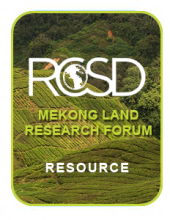/ library resources
Showing items 1 through 9 of 16.Since Vietnam shifted to a market-economy in the 1980s, Hanoi has seen rapid urban expansion similar to that of other South East Asian cities - involving megaprojects, luxury developments, rural-to-urban migration, informal housing construction, and escalating speculation.
The forest landscapes of the Greater Mekong Subregion (GMS) are changing dramatically, with a multitude of impacts from local to global levels. These changes invariably have their foundations in forest governance.
Land use models play an important role in exploring future land change dynamics and are instrumental to support the integration of knowledge in land system science.
Economic globalization promotes the economic development of underdeveloped regions but also influences the ecological environments of these regions, such as natural forest degradation.
This paper explores the political processes that activists engaged in contesting land grabbing have triggered to connect claims across borders and to international institutions, regimes and processes.
Concessions granted to investors in Cambodia have generated a deep sense of insecurity in rural forested areas. Villagers are not confined to a passive “everyday resistance of the poor,” as mentioned by James Scott, insofar as they frequently engage in frontal strategies for recovering land.
Between Vietnam's independence and its reunification in 1975, the country's socialist land tenure system was underpinned by the principle of "land to the tiller". During this period, government redistributed land to farmers that was previously owned by landlords.
Since the early 2000s the Lao government has dramatically increased the number of large-scale land concessions issued for agribusinesses.
Our main objective in this research was to examine the role of land ownership in the choice of household livelihood in the rural Mekong Delta region, Vietnam.
Pagination
Land Library Search
Through our robust search engine, you can search for any item of the over 73,000 highly curated resources in the Land Library.
If you would like to find an overview of what is possible, feel free to peruse the Search Guide.

